Python search and sorting algorithm example code analysis
Search
Binary search
Binary search is a method of searching for a specific value in an ordered array Element search algorithm. The search process starts from the middle element of the array. If the middle element is exactly the element to be found, the search process ends; if a specific element is greater than or less than the middle element, then the search is performed in the half of the array that is greater than or less than the middle element, and Just like the beginning, start the comparison from the middle element. If the array is empty at a certain step, it means it cannot be found. This search algorithm reduces the search range by half with each comparison.

# 返回 x 在 arr 中的索引,如果不存在返回 -1
def binarySearch (arr, l, r, x):
# 基本判断
if r >= l:
mid = int(l + (r - l)/2)
# 元素整好的中间位置
if arr[mid] == x:
return mid
# 元素小于中间位置的元素,只需要再比较左边的元素
elif arr[mid] > x:
return binarySearch(arr, l, mid-1, x)
# 元素大于中间位置的元素,只需要再比较右边的元素
else:
return binarySearch(arr, mid+1, r, x)
else:
# 不存在
return -1
# 测试数组
arr = [ 2, 3, 4, 10, 40]
x = int(input('请输入元素:'))
# 函数调用
result = binarySearch(arr, 0, len(arr)-1, x)
if result != -1:
print("元素在数组中的索引为 %d" % result)
else:
print("元素不在数组中")Run result:
Please enter the element: 4
The index of the element in the array is 2
Please enter the element: 5
The element is not in the array
Linear search
Linear search: It refers to checking each element in the array in a certain order until the specific value you are looking for is found.
def search(arr, n, x):
for i in range (0, n):
if (arr[i] == x):
return i
return -1
# 在数组 arr 中查找字符 D
arr = [ 'A', 'B', 'C', 'D', 'E' ]
x = input("请输入要查找的元素:")
n = len(arr)
result = search(arr, n, x)
if(result == -1):
print("元素不在数组中")
else:
print("元素在数组中的索引为", result)Running results:
Please enter the element you want to find: The index of the A
element in the array is 0
Please enter the element you want to find: a
The element is not in the array
Sort
Insertion sort
Insertion sort (Insertion Sort): is a simple and intuitive sorting algorithm. It works by constructing an ordered sequence. For unsorted data, it scans from back to front in the sorted sequence, finds the corresponding position and inserts it.
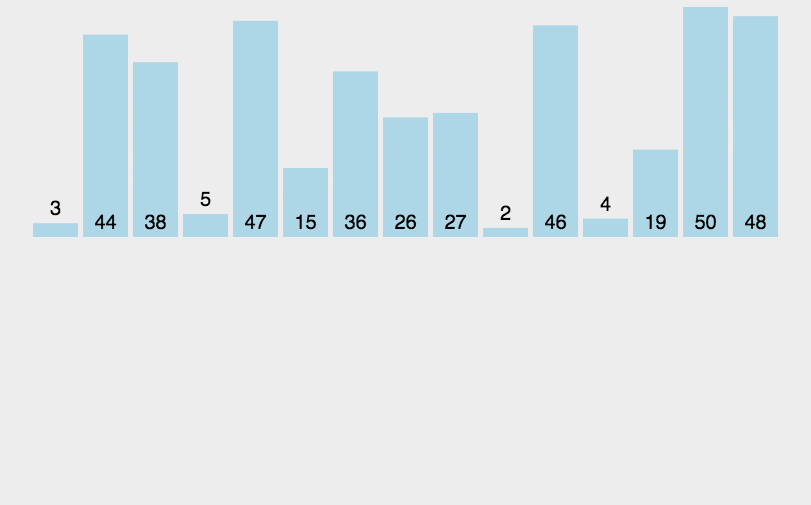
def insertionSort(arr):
for i in range(1, len(arr)):
key = arr[i]
j = i-1
while j >= 0 and key < arr[j]:
arr[j+1] = arr[j]
j -= 1
arr[j+1] = key
arr = [12, 11, 13, 5, 6, 7, 9, 9, 17]
insertionSort(arr)
print("排序后的数组:")
print(arr)Run result:
Sorted array:
[5, 6, 7, 9 , 9, 11, 12, 13, 17]
Of course you can also write it like this, which is more concise
list1 = [12, 11, 13, 5, 6, 7, 9, 9, 17]
for i in range(len(list1)-1, 0, -1):
for j in range(0, i):
if list1[i] < list1[j]:
list1[i], list1[j] = list1[j], list1[i]
print(list1)Quick sort
Quick sort;Use the divide and conquer strategy to divide a sequence (list) into two subsequences, a smaller one and a larger one, and then sort the two subsequences recursively.
The steps are:
#Select the reference value: Select an element from the sequence, called "base" (pivot);
Split:Reorder the sequence, all elements smaller than the baseline value are placed in front of the baseline, and all elements larger than the baseline value are placed in front of the baseline Behind the base (a number equal to the base value can go to either side). After this division is completed, the sorting of the reference value has been completed;
Recursively sort the subsequences:Recursively combine the subsequences of elements less than the reference value and greater than Subsequence ordering of base value elements.
The judgment condition for recursing to the bottom is that the size of the array is zero or one. At this time, the array is obviously in order.
There are several specific methods for selecting the benchmark value. This selection method has a decisive impact on the time performance of sorting.

def partition(arr, low, high):
i = (low-1) # 最小元素索引
pivot = arr[high]
for j in range(low, high):
# 当前元素小于或等于 pivot
if arr[j] <= pivot:
i = i+1
arr[i], arr[j] = arr[j], arr[i]
arr[i+1], arr[high] = arr[high], arr[i+1]
return (i+1)
# arr[] --> 排序数组
# low --> 起始索引
# high --> 结束索引
# 快速排序函数
def quickSort(arr, low, high):
if low < high:
pi = partition(arr, low, high)
quickSort(arr, low, pi-1)
quickSort(arr, pi+1, high)
return arr
arr = [10, 7, 8, 9, 1, 5]
n = len(arr)
print("排序后的数组:")
print(quickSort(arr, 0, n-1))Running results:
Sorted array:
[1, 5, 7, 8 , 9, 10]
Selection sort
Selection sort (Selection sort): is a simple and intuitive sorting algorithm. Here's how it works.
First find the smallest (large) element in the unsorted sequence and store it at the starting position of the sorted sequence. Then, continue to find the smallest (large) element from the remaining unsorted elements and put it in the sorted sequence. end of sequence. And so on until all elements are sorted.

A = [64, 25, 12, 22, 11]
for i in range(len(A)):
min_idx = i
for j in range(i+1, len(A)):
if A[min_idx] > A[j]:
min_idx = j
A[i], A[min_idx] = A[min_idx], A[i]
print("排序后的数组:")
print(A)Run result:
Sorted array:
[11, 12, 22, 25 , 64]
Bubble sort
Bubble Sort: is also a simple and intuitive sorting algorithm. It repeatedly walks through the sequence to be sorted, comparing two elements at a time and swapping them if they are in the wrong order. The work of visiting the array is repeated until no more exchanges are needed, which means that the array has been sorted. The name of this algorithm comes from the fact that smaller elements will slowly "float" to the top of the array through swapping.

def bubbleSort(arr):
n = len(arr)
# 遍历所有数组元素
for i in range(n):
# Last i elements are already in place
for j in range(0, n-i-1):
if arr[j] > arr[j+1]:
arr[j], arr[j+1] = arr[j+1], arr[j]
return arr
arr = [64, 34, 25, 12, 22, 11, 90]
print("排序后的数组:")
print(bubbleSort(arr))Run result:
Sorted array:
[11, 12, 22, 25 , 34, 64, 90]
归并排序
归并排序(Merge sort,或mergesort):,是创建在归并操作上的一种有效的排序算法。该算法是采用分治法(Divide and Conquer)的一个非常典型的应用。
分治法:
分割:递归地把当前序列平均分割成两半。
集成:在保持元素顺序的同时将上一步得到的子序列集成到一起(归并)。
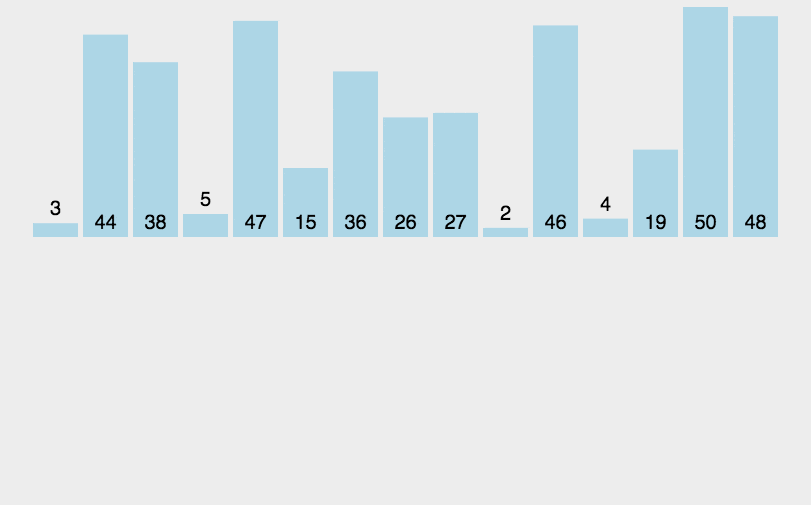
def merge(arr, l, m, r):
n1 = m - l + 1
n2 = r - m
# 创建临时数组
L = [0] * (n1)
R = [0] * (n2)
# 拷贝数据到临时数组 arrays L[] 和 R[]
for i in range(0, n1):
L[i] = arr[l + i]
for j in range(0, n2):
R[j] = arr[m + 1 + j]
# 归并临时数组到 arr[l..r]
i = 0 # 初始化第一个子数组的索引
j = 0 # 初始化第二个子数组的索引
k = l # 初始归并子数组的索引
while i < n1 and j < n2:
if L[i] <= R[j]:
arr[k] = L[i]
i += 1
else:
arr[k] = R[j]
j += 1
k += 1
# 拷贝 L[] 的保留元素
while i < n1:
arr[k] = L[i]
i += 1
k += 1
# 拷贝 R[] 的保留元素
while j < n2:
arr[k] = R[j]
j += 1
k += 1
def mergeSort(arr, l, r):
if l < r:
m = int((l+(r-1))/2)
mergeSort(arr, l, m)
mergeSort(arr, m+1, r)
merge(arr, l, m, r)
return arr
print ("给定的数组")
arr = [12, 11, 13, 5, 6, 7, 13]
print(arr)
n = len(arr)
mergeSort(arr, 0, n-1)
print("排序后的数组")
print(arr)运行结果:
给定的数组
[12, 11, 13, 5, 6, 7, 13]
排序后的数组
[5, 6, 7, 11, 12, 13, 13]
堆排序
堆排序(Heapsort):是指利用堆这种数据结构所设计的一种排序算法。堆积是一个近似完全二叉树的结构,并同时满足堆积的性质:即子结点的键值或索引总是小于(或者大于)它的父节点。堆排序可以说是一种利用堆的概念来排序的选择排序。
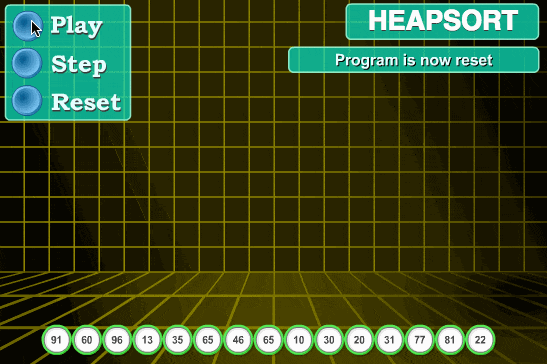
def heapify(arr, n, i):
largest = i
l = 2 * i + 1 # left = 2*i + 1
r = 2 * i + 2 # right = 2*i + 2
if l < n and arr[i] < arr[l]:
largest = l
if r < n and arr[largest] < arr[r]:
largest = r
if largest != i:
arr[i], arr[largest] = arr[largest], arr[i] # 交换
def heapSort(arr):
n = len(arr)
# Build a maxheap.
for i in range(n, -1, -1):
heapify(arr, n, i)
# 一个个交换元素
for i in range(n-1, 0, -1):
arr[i], arr[0] = arr[0], arr[i] # 交换
heapify(arr, i, 0)
return arr
arr = [12, 11, 13, 5, 6, 7, 13, 18]
heapSort(arr)
print("排序后的数组")
print(heapSort(arr))运行结果:
排序后的数组
[5, 6, 7, 12, 11, 13, 13, 18]
计数排序
计数排序:的核心在于将输入的数据值转化为键存储在额外开辟的数组空间中。作为一种线性时间复杂度的排序,计数排序要求输入的数据必须是有确定范围的整数。
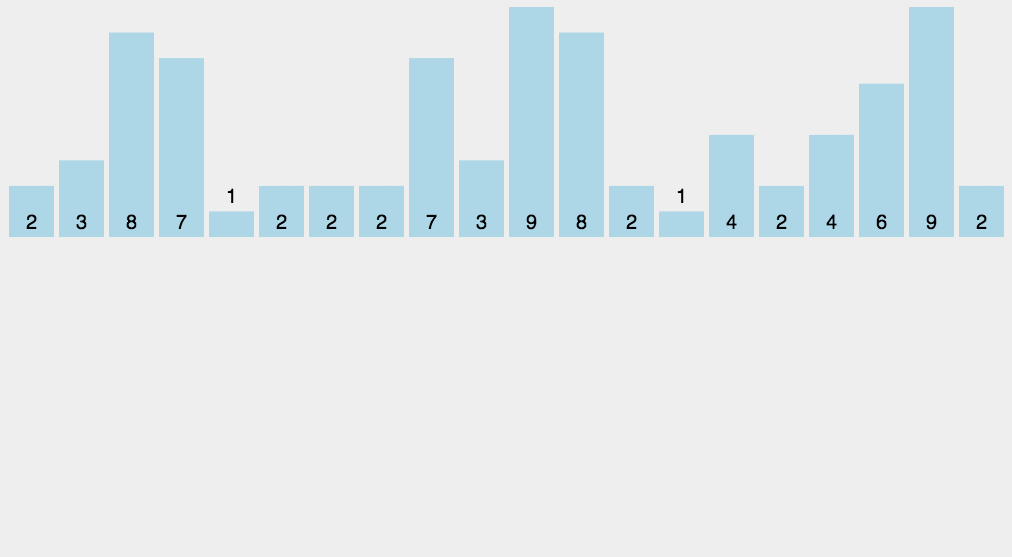
def countSort(arr):
output = [0 for i in range(256)]
count = [0 for i in range(256)]
ans = ["" for _ in arr]
for i in arr:
count[ord(i)] += 1
for i in range(256):
count[i] += count[i-1]
for i in range(len(arr)):
output[count[ord(arr[i])]-1] = arr[i]
count[ord(arr[i])] -= 1
for i in range(len(arr)):
ans[i] = output[i]
return ans
arr = "wwwnowcodercom"
ans = countSort(arr)
print("字符数组排序 %s" %("".join(ans)))运行结果:
字符数组排序 ccdemnooorwwww
希尔排序
希尔排序:也称递减增量排序算法,是插入排序的一种更高效的改进版本。但希尔排序是非稳定排序算法。
希尔排序的基本思想是:先将整个待排序的记录序列分割成为若干子序列分别进行直接插入排序,待整个序列中的记录"基本有序"时,再对全体记录进行依次直接插入排序。
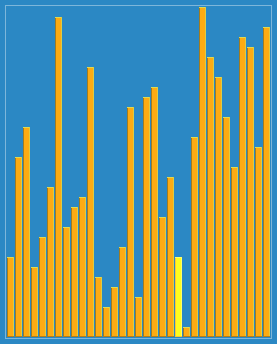
def shellSort(arr):
n = len(arr)
gap = int(n/2)
while gap > 0:
for i in range(gap, n):
temp = arr[i]
j = i
while j >= gap and arr[j-gap] > temp:
arr[j] = arr[j-gap]
j -= gap
arr[j] = temp
gap = int(gap/2)
return arr
arr = [12, 34, 54, 2, 3, 2, 5]
print("排序前:")
print(arr)
print("排序后:")
print(shellSort(arr))运行结果:
排序前:
[12, 34, 54, 2, 3, 2, 5]
排序后:
[2, 2, 3, 5, 12, 34, 54]
拓扑排序
对一个有向无环图(Directed Acyclic Graph简称DAG)G进行拓扑排序,是将G中所有顶点排成一个线性序列,使得图中任意一对顶点u和v,若边(u,v)∈E(G),则u在线性序列中出现在v之前。通常,这样的线性序列称为满足拓扑次序(Topological Order)的序列,简称拓扑序列。拓扑排序是一种将集合上的偏序转换为全序的操作。
在图论中,由一个有向无环图的顶点组成的序列,当且仅当满足下列条件时,称为该图的一个拓扑排序(英语:Topological sorting):
每个顶点出现且只出现一次;若A在序列中排在B的前面,则在图中不存在从B到A的路径。
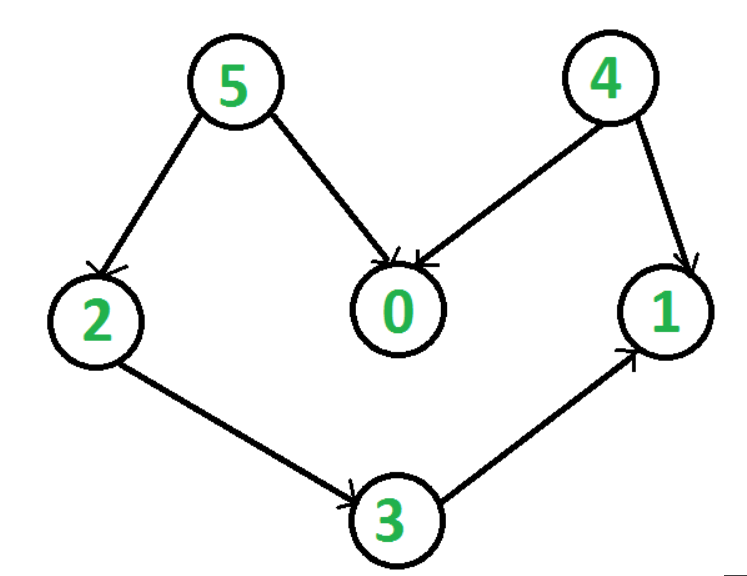
from collections import defaultdict
class Graph:
def __init__(self, vertices):
self.graph = defaultdict(list)
self.V = vertices
def addEdge(self, u, v):
self.graph[u].append(v)
def topologicalSortUtil(self, v, visited, stack):
visited[v] = True
for i in self.graph[v]:
if visited[i] == False:
self.topologicalSortUtil(i, visited, stack)
stack.insert(0,v)
def topologicalSort(self):
visited = [False]*self.V
stack = []
for i in range(self.V):
if visited[i] == False:
self.topologicalSortUtil(i, visited, stack)
print(stack)
g= Graph(6)
g.addEdge(5, 2)
g.addEdge(5, 0)
g.addEdge(4, 0)
g.addEdge(4, 1)
g.addEdge(2, 3)
g.addEdge(3, 1)
print("拓扑排序结果:")
g.topologicalSort()运行结果:
拓扑排序结果:
[5, 4, 2, 3, 1, 0]
The above is the detailed content of Python search and sorting algorithm example code analysis. For more information, please follow other related articles on the PHP Chinese website!

Hot AI Tools

Undresser.AI Undress
AI-powered app for creating realistic nude photos

AI Clothes Remover
Online AI tool for removing clothes from photos.

Undress AI Tool
Undress images for free

Clothoff.io
AI clothes remover

Video Face Swap
Swap faces in any video effortlessly with our completely free AI face swap tool!

Hot Article

Hot Tools

Notepad++7.3.1
Easy-to-use and free code editor

SublimeText3 Chinese version
Chinese version, very easy to use

Zend Studio 13.0.1
Powerful PHP integrated development environment

Dreamweaver CS6
Visual web development tools

SublimeText3 Mac version
God-level code editing software (SublimeText3)

Hot Topics
 1669
1669
 14
14
 1428
1428
 52
52
 1329
1329
 25
25
 1273
1273
 29
29
 1256
1256
 24
24
 PHP and Python: Different Paradigms Explained
Apr 18, 2025 am 12:26 AM
PHP and Python: Different Paradigms Explained
Apr 18, 2025 am 12:26 AM
PHP is mainly procedural programming, but also supports object-oriented programming (OOP); Python supports a variety of paradigms, including OOP, functional and procedural programming. PHP is suitable for web development, and Python is suitable for a variety of applications such as data analysis and machine learning.
 Choosing Between PHP and Python: A Guide
Apr 18, 2025 am 12:24 AM
Choosing Between PHP and Python: A Guide
Apr 18, 2025 am 12:24 AM
PHP is suitable for web development and rapid prototyping, and Python is suitable for data science and machine learning. 1.PHP is used for dynamic web development, with simple syntax and suitable for rapid development. 2. Python has concise syntax, is suitable for multiple fields, and has a strong library ecosystem.
 How to run sublime code python
Apr 16, 2025 am 08:48 AM
How to run sublime code python
Apr 16, 2025 am 08:48 AM
To run Python code in Sublime Text, you need to install the Python plug-in first, then create a .py file and write the code, and finally press Ctrl B to run the code, and the output will be displayed in the console.
 PHP and Python: A Deep Dive into Their History
Apr 18, 2025 am 12:25 AM
PHP and Python: A Deep Dive into Their History
Apr 18, 2025 am 12:25 AM
PHP originated in 1994 and was developed by RasmusLerdorf. It was originally used to track website visitors and gradually evolved into a server-side scripting language and was widely used in web development. Python was developed by Guidovan Rossum in the late 1980s and was first released in 1991. It emphasizes code readability and simplicity, and is suitable for scientific computing, data analysis and other fields.
 Python vs. JavaScript: The Learning Curve and Ease of Use
Apr 16, 2025 am 12:12 AM
Python vs. JavaScript: The Learning Curve and Ease of Use
Apr 16, 2025 am 12:12 AM
Python is more suitable for beginners, with a smooth learning curve and concise syntax; JavaScript is suitable for front-end development, with a steep learning curve and flexible syntax. 1. Python syntax is intuitive and suitable for data science and back-end development. 2. JavaScript is flexible and widely used in front-end and server-side programming.
 Golang vs. Python: Performance and Scalability
Apr 19, 2025 am 12:18 AM
Golang vs. Python: Performance and Scalability
Apr 19, 2025 am 12:18 AM
Golang is better than Python in terms of performance and scalability. 1) Golang's compilation-type characteristics and efficient concurrency model make it perform well in high concurrency scenarios. 2) Python, as an interpreted language, executes slowly, but can optimize performance through tools such as Cython.
 Where to write code in vscode
Apr 15, 2025 pm 09:54 PM
Where to write code in vscode
Apr 15, 2025 pm 09:54 PM
Writing code in Visual Studio Code (VSCode) is simple and easy to use. Just install VSCode, create a project, select a language, create a file, write code, save and run it. The advantages of VSCode include cross-platform, free and open source, powerful features, rich extensions, and lightweight and fast.
 How to run python with notepad
Apr 16, 2025 pm 07:33 PM
How to run python with notepad
Apr 16, 2025 pm 07:33 PM
Running Python code in Notepad requires the Python executable and NppExec plug-in to be installed. After installing Python and adding PATH to it, configure the command "python" and the parameter "{CURRENT_DIRECTORY}{FILE_NAME}" in the NppExec plug-in to run Python code in Notepad through the shortcut key "F6".




